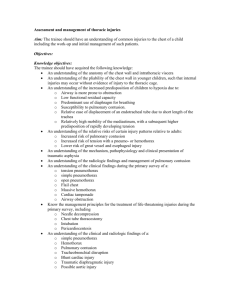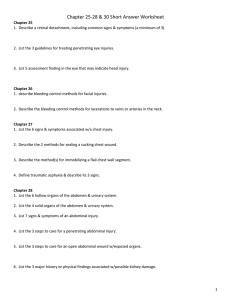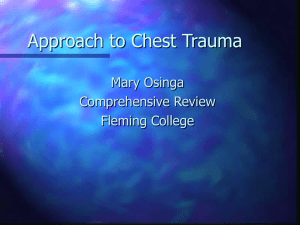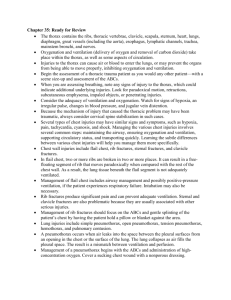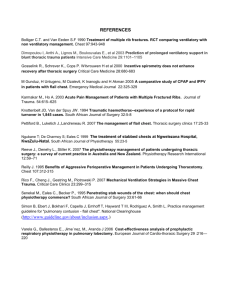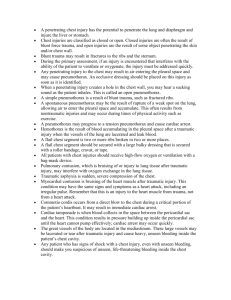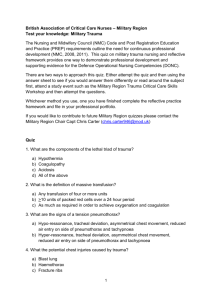2. chest trauma
advertisement
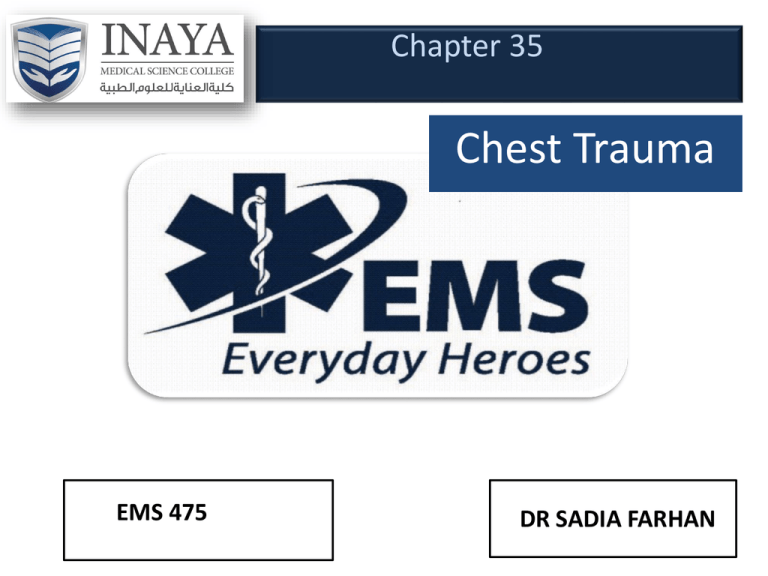
Chapter 35 Chest Trauma EMS 475 DR SADIA FARHAN Learning objectives At the end of this lecture students must be able to: • Interpret the basics of clinical anatomy of thorax • Describe the basics of pathophysiology related to thoracic injuries • Interpret the immediate general management of patient with thoracic injuries • Recognize and differentiate between the fractures of thoracic cage • Outline the emergency field management of common injuries of lungs, heart and medistional structures • Prioritize and justify the referral of patient to trauma centre according to the assessment of thoracic trauma Introduction • Annually, thoracic trauma causes: • One in four trauma deaths are due to thoracic injuries. © PhotoStock-Israel /Alamy Images – 700,000 + emergency department visits – 18,000+ deaths Anatomy • Thorax—bony cage over chest organs Anatomy • Diaphragm inserts below 4th or 5th rib – Size/dimension of thoracic cavity varies during respiration Anatomy • Sternum – Consists of: • Superior manubrium • Central sternal body • Inferior xyphoid process • Clavicle – Connects to the manubrium and overlies the first rib • Scapula – Overlies posterior aspect of the upper thoracic cage Anatomy • 12 pairs of ribs attach to 12 thoracic vertebrae. – First 7 pairs attach directly to sternum – 8–10 attach indirectly to sternum – 11 and 12 are “floating ribs” Anatomy • Intercostal space houses: – Intercostal muscles – Neurovascular bundle • Mediastinum contains: – – – – – – Heart and great vessels Esophagus Lymphatic channels Trachea Mainstem bronchi Vagus and phrenic nerves Anatomy • Heart resides inside pericardium – Anterior portion is the right ventricle – Mostly protected anteriorly by the sternum – Average cardiac output: volume of blood pumped by heart in one minute stroke volume ×pulse rate/ min 70 × 70 = 4,900 mL/min Anatomy • Aorta: largest artery in body – Three points of attachment: • Annulus • Ligamentum arteriosum • Aortic hiatus • Lungs occupy most space in thoracic cavity – Lined with pleura – Pleura is separated by viscous fluid • Keeps lungs from collapsing on exhalation Anatomy • Diaphragm: primary breathing muscle – Breathing effort can be helped by accessory muscles. Physiology • Primary functions of thorax: – Maintain oxygenation and ventilation. – Maintain circulation. • Breathing process includes: – Delivery of oxygen to body – Elimination of carbon dioxide Physiology • Brain stimulates breathing via chemoreceptors. – If CO2 is too high, respiratory rate increases. – Hypoxic drive: secondary mechanism • Intercostal and accessory muscles pull chest wall away from the body as the diaphragm contracts downward. – Negative pressure draws air through mouth and nose to alveolar spaces. • Replaces air in the alveoli Physiology • Blood is delivered by pulmonary circulation to capillaries adjacent to alveoli. – Has low O2 and high CO2 concentrations – Oxygenation process delivers O2 to blood • Ventilation: how CO2 leaves the body – CO2 diffuses down its concentration gradient and enters air within the alveoli. – Positive pressure is created within the thorax and air is exhaled. Pathophysiology • Traumatic injury to chest may compromise: – Ventilation – Oxygenation – Circulation • Two mechanisms of injury: – Blunt – Penetrating • Two basic injury patterns – Closed – Open Pathophysiology • Blunt trauma may lead to: – Fracture of ribs, sternum, areas of chest wall – Bruise of lungs and heart – Damage to aorta – Broken ribs lacerating intrathoracic organs – Organs torn from attachment Pathophysiology • Thoracic trauma may impair cardiac output. – Blood loss – Pressure change – Vital organ damage – Combination of these Pathophysiology • Ventilatory impairments can be rapidly fatal. – Shallow breathing reduces minute volume. – Air entering pleural space compresses lungs and decreases tidal volume. – Blood collection prevents full lung expansion. Pathophysiology • Other complications include: – Atelectasis reduces area for gas exchange. – Bruised lung tissue may cause hypoxemia. – Tearing or rupture of respiratory structures prevents O2 from reaching alveoli. Scene Size-Up • Be sure scene is safe to enter. • Follow standard precautions. • After identifying number of patients: – Triage patients and request resources. – Determine MOI if possible. Primary Assessment • Form a general impression. – Assess level of consciousness. – Observe the neck for: • Accessory muscle use during breathing • Extended or engorged external jugular veins • Airway and breathing – Assess while performing spinal immobilization. – Signs of obstruction may include: • Stridor • Hoarseness • Alterations in mental status Primary Assessment • Airway and breathing (cont’d) – Abnormal findings may include: • Tachypnea • Hemoptysis • Retractions – Immediate manage airway impairment: • Manually immobilize patient. • Use jaw-thrust maneuver. – Identify and manage impairment of oxygenation and ventilation. Primary Assessment • Airway and breathing (cont’d) – Address life-threats first. – Apply occlusive dressing to penetrating injuries. – Assess ventilation and oxygenation. • Evaluate skin circulation. • Decreasing O2 saturation may indicate hypoxia. • Watch for impending tension pneumothorax signs. Primary Assessment • Circulation – Check pulses. • Tachycardia is not always associated with hypovolemia. • Low heart rate does not rule out hypovolemia or shock. • Thready or weak pulse may suggest volume loss. Primary Assessment • Circulation (cont’d) – Irregular pulse suggests: • Hypoxia • Hypoperfusion • Serious underlying injuries or shock – Auscultate the heart. • Note if heart sounds are easily heard or muffled. – If shock suggested, may not be from thorax. • Obtain history and complete physical. Primary Assessment • Transport decision – Priorities: patients with ABC problems – If signs of poor perfusion/ – inadequate breathing: • Transport quickly. • Perform assessment en route. History Taking • May need to be done en route • Obtain relevant patient history (SAMPLE). • Questions about event should focus on MOI. Secondary Assessment • Includes a head-to-toe assessment – Check for injuries that may compromise ABCs. • Obtain full set of vitals. • Monitoring equipment can aid assessment • If chest injury is isolated with limited MOI, focus on: – Isolated injury – Patient’s complaint – Body region affected Secondary Assessment • If significant trauma affects multiple systems: – Perform full body scan using DCAP-BTLS. – Inspect region for deformities. – Palpate for tenderness. – Check for lacerations and swelling. Reassessment • Obtain repeated assessments of: – Vital signs – Oxygenation – Circulation – Breath sounds • If pneumothorax is suspected, patient should be considered unstable. – Reassess at least every 5 minutes. Flail Chest • May result from blunt force mechanisms • Two or more adjacent ribs fractured in two or more places – Segment becomes separated from chest wall Flail Chest • Location and size affects degree that chest wall and air movement are impaired. – Flail sternum (most extreme) • Underlying pressure causes paradoxical movement of segment and rest of chest wall. • May not be initially apparent – Palpate for rib cage fractures and crepitus. Flail Chest • Pneumothorax or hemothorax may occur if bone fragments are driven into the body. – Pain may prevent adequate tidal volume. • Limits the ability to compensate for flail segment • Management may involve: – Positive-pressure ventilation – Positive end-expiratory pressure Flail Chest • Assessment and management – Signs and symptoms include: • Hypoxia • Hypercarbia • Pain – Palpation may reveal: • Crepitus • Tenderness • Dissection of air into tissue – Auscultation may reveal: • Decreased or absent breath sounds Flail Chest • Assessment and management (cont’d) – Poses a threat to patient’s ability to breathe • Intubation and positive-pressure ventilation may be needed. – Stabilization of flail segment is controversial. Rib Fractures • Most common thoracic injury – Pain contributes to: • Inadequate ventilation • Atelectasis • Pneumonia from inadequate respiration • Blunt trauma may result in fracture at: • Point of impact • Edge of object • Posterior angle of rib Rib Fractures • Associated injuries can be: – Ribs 4–9 • • • • Aortic injury Tracheobronchial injury Pneumothorax Vascular injury – Ribs 9–11 • Intra-abdominal injury Rib Fractures – Patients report: • Pleuritic chest pain • Mild dyspnea – Exam shows: • • • • Chest wall tenderness Soft-tissue injury Crepitus Subcutaneous emphysema Rib Fractures • Assessment and management (cont’d) – Management focuses on: • ABCs and evaluating for other injuries – Administer supplemental O2 – Gently splint chest wall. – Consider intravenous analgesic. Sternal Fractures • One in 20 patients with blunt thoracic trauma can have sternal fracture – Associated with other injuries, including: • Myocardial contusions • Intra-abdominal injuries • Assessment and management – Patient reports pain over anterior part of chest. – Palpation may reveal: • Tenderness • Crepitus • Possible flail segment Sternal Fractures • Assessment and management (cont’d) – Perform an ECG rhythm analysis. – Supportive treatment only • ABCs • Manage associated injuries. • Analgesics Clavicle Fractures • One of the most common fractures • Assessment and management – Patient will: • Report pain in the shoulder • Usually hold arm across front of body – Splint fracture with a sling and swathe. • Apply gentle upward support to the olecranon process of the ulna. • Knot should be tied on the side of the neck Br ak Simple Pneumothorax • Accumulation of air/gas in pleural cavity – Air enters through a hole in the chest wall or lung causes lung collapse on affected side • Delayed or improper treatment may lead to a tension pneumothorax Simple Pneumothorax • Assessment and management (cont’d) – Cover large open wounds immediately. • Nonporous dressing secured on three sides – Maintain ABCs, provide high-concentration O2. • If tension develops, dressing may need to be removed to release trapped air. Open Pneumothorax • Occurs when chest wall defect allows air into thoracic space – Results from penetrating chest trauma – Negative pressure draws air into pleural space. – As size increases, lung loses ability to expand. Open Pneumothorax • If hole is larger than glottis opening, air is likely to enter chest wall. – Creates a “sucking chest wound” Open Pneumothorax • Assessment and management – Signs and symptoms may include: • Tachycardia and tachypnea • Restlessness – Physical assessment shows: • • • • • Chest wall defect Impaled object Sucking chest wound Bubbling wound Subcutaneous emphysema Open Pneumothorax • Assessment and management (cont’d) – Treat immediately. • Convert wound to a closed injury. • Place on high-flow supplemental O2 via nonrebreathing mask. Tension Pneumothorax • Life-threatening condition from air accumulation within interpleural space – Results from open or closed injury Tension Pneumothorax • As air accumulates, pressure builds against surrounding tissue. – Compresses the lung, which diminishes: • Ability to oxygenate blood • Ability to eliminate CO2 • Pressure causes eventual lung collapse and mediastinum to shift. – May exceed pressure in major venous structures – If venous return decreases, the body will increase heart rate. Tension Pneumothorax • Assessment and management – Classic signs may include: • Absence of breath sounds on affected side • Pulsus paradoxus • Tracheal deviation – Tachycardia is induced because blood cannot return to heart. • Accumulates in great vessels • Pressure pushes blood into jugular vein. Tension Pneumothorax • Assessment and management (cont’d) – During normal inspiration: • Negative pressure decreases blood return. • Preload and systolic blood pressure decrease. – Jugular veins are distended when engorged 1 to 2 cm above the clavicle. – May show: – trachea deviation from affected side – diminished breath sounds – pleuritic chest pain and dyspnea Tension Pneumothorax • Assessment and management (cont’d) – Administer immediate high-flow supplemental O₂. – Inspect the chest. – Cover open wounds with dressing. – If elevated pressure is suggested: • May need to perform a needle decompression Hemothorax • Occurs when blood accumulates within pleura – Commonly caused by lung parenchyma tearing – Collection of blood compresses and displaces lung Hemothorax • Hemopneumothorax – Blood and air in the pleural space • Massive hemothorax – Accumulation of more than 1,500 mL of blood within pleura Hemothorax • Assessment and management – Signs include: • Ventilatory insufficiency • Hypovolemic shock – Findings that differentiate from other injuries: • • • • Lack of tracheal deviation Dullness on percussion Flat neck veins with hypovolemia Distended neck veins with increased pressure Hemothorax • Assessment and management (cont’d) – Prehospital management: • • • • Supportive care Rapid transport High-flow supplemental O2 Two large-bore peripheral IV Pulmonary Contusion • Alveolar and capillary damage results from lung tissue compression against chest wall. – Injury may lead to: • Loss of fluid and blood into involved tissues • White blood cell migration into area • Local tissue edema • Local surfactant in alveoli is diluted. – Causes atelectasis • Delivery of O2 is reduced, causing hypoxia Pulmonary Contusion • Assessment and management – Hypoxia and CO2 retention may cause: • Respiratory distress • Tachycardia • Agitation – Auscultation may reveal: • • • • Wheezes Rhonchi Rales Diminished lung sounds Pulmonary Contusion • Assessment and management (cont’d) – Treatment includes: • Managing airway • Using caution when administering IV fluids • Administering small amounts of analgesics for pain Cardiac Tamponade • Excessive fluid in pericardial sac, causing – Compression of the heart – Decreased cardiac output Cardiac Tamponade • Hemodynamic effects determined by: – Size of pericardium perforation – Rate of hemorrhage – Chamber of heart involved • Mortality varies. • Can occur in both medical and trauma conditons – Medical—slow fluid collection – Trauma—bleeding is rapid. Cardiac Tamponade • Continued bleeding increases pressure in the pericardium. – Atria and vena cavae compress. – Preload delivery is drastically reduced. – Heart increases rate to compensate. Cardiac Tamponade • Assessment and management – 30% diagnosed will have Beck triad: • Muffled heart tones • Hypotension • JVD – Classic finding: electrical alternans in ECG strip – Findings typical of shock, including: • Weak or absent peripheral pulses • Cyanosis • Tachycardia or tachypnea Electrical alternans Cardiac Tamponade • Assessment and management (cont’d) – Treatment includes: • • • • Assess and manage ABCs. Ensure adequate O2 and establishing IV access. Provide a rapid fluid bolus. Rapidly transfer to trauma center. Cardiac Tamponade versus Tension Pneumothorax Myocardial Contusion • Sudden deceleration of chest wall may cause collision of heart to sternum. – Characterized by: • Local tissue contusion and hemorrhage • Edema • Cellular damage within myocardium Myocardial Contusion • Damage to myocardial tissues may cause: – Ectopic activity – Dysrhythmias • Structural changes may include: – Ventricular septal defect – Myocardial rupture or aneurysm – Coronary artery occlusion Myocardial Contusion • Assessment and management – Signs and symptoms include: • Sharp, retrosternal chest pain • Soft-tissue or bony injury in area • Crackles or rales on auscultation – Treatment includes: • Nonspecific supportive care • Fluid resuscitation • Consulting with medical control before administering antidysrhythmic agents Commotio Cordis • Cardiac arrest caused by a direct blow to the thorax during the repolarization period – Result of chest wall impact directly over heart – Second most common cause of sudden cardiac death in young male athletes Commotio Cordis • Assessment and management – Signs and symptoms may include: • Unresponsiveness • Cyanotic • Tonic-clonic seizures – Survival rates increased because of: • Increased awareness • CPR preparation • Accessibility of AED at sporting events Traumatic Aortic Disruption • Dissection or rupture of the aorta • Usually caused by crashes and falls – Aorta is injured at fixed points by shearing forces. – Impact causes the aortic arch to swing forward. – Tension and area rotation cause aorta to rupture at point of attachment. Traumatic Aortic Disruption • If intima is torn, blood can dissect along the media. • Severe injuries may allow blood to leak from all layers. Traumatic Aortic Disruption • Assessment and management – Symptoms vary and may include: • • • • Tearing pain behind sternum or in the scapula Hypovolemic shock Dyspnea Altered mental state – Recognition often from suspicion based on MOI • Assessment of extremity pulses is important Traumatic Aortic Disruption • Assessment and management (cont’d) – Assess and manage ABCs. – Gradual IV hydration to treat hypotension – Do not use pressor agents. – Expedite transport to trauma center. Great Vessel Injury • Great vessels protected by bony structures and other tissues (except for aorta) – Injuries more likely with penetrating trauma – Injuries may result in occlusion or artery spasm • .Presentation may include: – – – – – Pain Pallor Paresthesias Pulselessness Paralysis Great Vessel Injury • Assessment and management – If bleeding not prevented, presentation includes: • Hypovolemic shock • Hemothorax • Cardiac tamponade – Procedures for acute blood loss • Establish IV for hydration during transport. • Treat pericardial tamponade immediately. • Do not use pneumatic antishock garment. Diaphragmatic Injuries • Occurs in a small percentage of trauma • Most occur on left side – Liver protects right side. • Recovery is inhibited by pressure differences between abdominal and thoracic cavities. Diaphragmatic Injuries • Three phases: – Acute—begins at injury; ends with recovery from other injuries – Latent—entrapment of abdominal contents – Obstructive—abdominal contents herniate through defect • Tension gastrothorax – Herniation of abdominal contents into thoracic cavity, causing pressure to: • Compress lung on affected side. • Compromise circulatory function. Diaphragmatic Injuries © SIU Bio Med Comm./Custom Medical Stock Photo Diaphragmatic Injuries • Assessment and management (cont’d) – Acute phase: • • • • • Hypotension Tachypnea Bowel sounds in chest Chest pain Absent breath sounds – Obstructive phase: • • • • • Nausea and vomiting Abdominal pain Constipation Dyspnea Abdominal distension Diaphragmatic Injuries • Assessment and management (cont’d) – Management focus: maintaining oxygen and providing rapid transport • Elevate head of backboard. • Positive-pressure ventilation • NG tube placement (if allowed by protocol) – Definative surgical repair Esophageal Injuries • Rapidly fatal injury in GI system • Assessment and management – Signs and symptoms include: • Pleuritic chest pain • Subcutaneous emphysema • Associated tracheal injury – No specific therapy in the prehospital setting – Do not give anything orally. Tracheobronchial Injuries • Rare, typically caused by penetrating injuries – High mortality rate – Allows for rapid movement of air into pleural space, causing a pneumothorax • May progress to tension pneumothorax Tracheobronchial Injuries • Assessment and management – Presentation varies and may include: • Hoarseness • Dyspnea and tachycardia • Respiratory distress – Focuses on ABCs • Bag-bask ventilation instead of intubation • Avoid high ventilatory pressure. Traumatic Asphyxia • Induced by traumatic injury that forcefully compresses the thoracic cavity – Causes pressure to major veins of the head, neck, and kidneys • Causes rupture of the capillary beds Traumatic Asphyxia • Assessment and management – Physical findings: • Cyanosis of head, upper extremities, and torso • Ocular hemorrhage • Swollen and cyanotic facial structures © Chuck Stewart, MD. Traumatic Asphyxia • Assessment and management (cont’d) – Provide high-flow supplemental O2. – Take cervical spine precautions. – Obtain IV access with two large-bore IV lines. – Transport to nearest trauma center. Traumatic Asphyxia • Assessment and management (cont’d) – Provide high-flow supplemental O2. – Take cervical spine precautions. – Obtain IV access with two large-bore IV lines. – Transport to nearest trauma center. Summary • Thorax contains ribs, thoracic vertebrae, clavicle, scapula, sternum, heart, lungs, diaphragm, great vessels, esophagus, lymphatic channels, trachea, mainstem bronchi, and nerves. • Oxygenation, ventilation, and some aspects of circulation take place in the thorax. • Thoracic injuries can cause air or blood in the lungs or prevent organs from moving properly. Summary • A thoracic trauma assessment begins with scene size-up and ABCs assessment. • When assessing breathing, note any injury to the thorax, which may indicate underlying injuries. • Consider ventilation and oxygenation adequacy. • Always consider spine stabilization. Summary • Managing chest injuries includes maintaining airway, ensuring oxygenation and ventilation, supporting circulation, and transporting quickly. • Chest wall injuries include flail chest, rib fractures, sterna fractures, and clavicle fractures. • In flail chest, two or more ribs are broken in two or more places, which can result in a free-floating rib segment. Summary • Flail chest management includes airway management and possible positive-pressure ventilation. • Rib fractures cause significant pain and may prevent adequate ventilation. • Rib fracture management should focus on the ABCs and gentle splinting of the chest. Summary • Lung injuries include simple pneumothorax, open pneumothorax, tension pneumothorax, hemothorax, and pulmonary contusion. • In a pneumothorax, air leaks into the pleural space from an opening in the chest or the surface of the lung. • Management of a pneumothorax starts with the ABCs and high-concentration oxygen administration. Summary • A tension pneumothorax results from air collection in the pleural space, and is a lifethreatening condition. • Patients with a tension pneumothorax should be placed on high-flow supplemental oxygen via a nonrebreathing mask. Cover open wounds with a nonporous or occlusive dressing. Summary • A hemothorax is the accumulation of blood between the parietal and visceral pleura. • If a patient with a hemothorax does not require airway intervention, place the patient on high-flow supplemental oxygen via a nonrebreathing mask. • A hemopneumothorax is the collection of both blood and air in the pleural space. Summary • A pulmonary contusion occurs from compression of the lung, resulting in alveolar and capillary damage, edema, and hypoxia. • If a patient has a pulmonary contusion or cardiac tamponade, assess and manage the ABCs and consider administering IV fluids. • Myocardial injuries include cardiac tamponade, myocardial contusion, myocardial rupture, and commotio cordis. Summary • Cardiac tamponade occurs when excessive fluid builds up in the pericardial sac around the heart, which compresses the heart and compromises stroke volume. • Treating cardiac tamponade begins by managing the ABCs, ensuring adequate oxygen delivery, and establishing IV access. Pericardiocentesis is the ultimate treatment option. Summary • Myocardial contusion is blunt trauma to the heart, and may cause hemorrhage, edema, and cellular damage. • Management for myocardial contusion is supportive, but should also include cardiac monitoring and establishing IV access. • Myocardial rupture is perforation of one or more elements of the anatomy of the heart, occurring from blunt or penetrating trauma. Summary • Management for myocardial rupture should include supportive care and rapid transport to a trauma center for a thoracotomy. • Commotio cordis occurs from a direct blow to the chest during a critical portion of the heart’s repolarization period. • ALS treatment for commotio cordis must follow standard ACLS guidelines for sudden cardiac arrest. Summary • Vascular injuries include traumatic aortic disruption and great vessel injury. • Traumatic aortic disruption is the ripping of the aorta. • Management for traumatic aortic disruption focuses on symptom control. • Other injuries include diaphragmatic injuries, esophageal injuries, tracheobronchial injuries, and traumatic asphyxia. Credits • Chapter opener: Courtesy of ED, Royal North Shore Hospital/NSW Institute of Trauma & Injury • Backgrounds: Blue–Jones & Bartlett Learning. Courtesy of MIEMSS; Gold–Jones & Bartlett Learning. Courtesy of MIEMSS; Green–Courtesy of Rhonda Beck; Red–© Margo Harrison/ShutterStock, Inc. • Unless otherwise indicated, all photographs and illustrations are under copyright of Jones & Bartlett Learning, courtesy of Maryland Institute for Emergency Medical Services Systems, or have been provided by the American Academy of Orthopaedic Surgeons.
